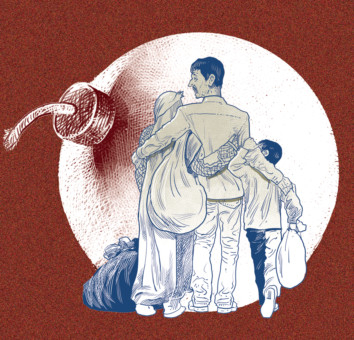
Over the past seven years, Europe has been in crisis mode almost without interruption. From Ukraine to Greece, events have led the continent from the frying pan to the fire and back again, with all of the attendant summitry, declarations, and brinkmanship. Now, it is a migration crisis — one that is unlikely to be resolved in the foreseeable future — that is commanding the European Union’s (EU) attention. But, if Europe is to respond effectively, it must move beyond crisis mode to understand both what it is facing and what it wants to achieve.
It is indisputable that migration deserves the EU’s focus. Not only are refugee flows into Europe shattering records from one month to the next; refugees’ primary entry points are changing as well. Meanwhile, the already-hazy lines between asylum-seekers, refugees, displaced persons, and purely economic refugees are becoming increasingly difficult to distinguish at all.
The dangerous conditions of the refugees’ journey constitute a serious humanitarian crisis. Since the beginning of this year, roughly 2,500 people have died attempting to cross the Mediterranean, to say nothing of gruesome scenes like the recent discovery of 71 decomposing bodies in an abandoned truck in Austria. Thousands more languish in makeshift camps with little or no support.
To make matters worse, there has been a steady stream of migration-related violence across Europe, from an arson attack on a planned refugee shelter in Germany to police brutality against refugees in Macedonia and Hungary. The port of Calais has become a chokepoint of the crisis, with refugees desperately trying to force their way onto trucks and trains bound for the United Kingdom.
The situation screams “emergency” — and has triggered a response by the EU. Most notably, the EU has tripled the budget of Operation Triton, designed to strengthen border security; launched an EU-wide naval operation against human smugglers and traffickers in the Mediterranean (EUNAVFOR Med); and allocated additional funds to overwhelmed frontline member countries.
Some individual member countries have also acted. Most notably, Germany, despite facing the arrival of a predicted 800,000 asylum-seekers this year, has suspended implementation of the EU’s Dublin Regulation, which would have led to the deportation of thousands of Syrian refugees.
But these measures, though helpful, are far from adequate. In fact, they are examples of crisis-mode policymaking, which tends to favour impressive-seeming stopgap measures (not to mention lofty declarations that can verge on hollowness or hyperbole), instead of real solutions. By allowing EU leaders to avoid acknowledging the long-term nature of the refugee challenge, this approach weakens their motivation to take collective action. And, indeed, a reluctance to cooperate was on display at last month’s meeting of the EU’s Justice and Home Affairs Council, where representatives failed to produce an arrangement on how to distribute the paltry 40,000 refugees that the European Council agreed to accept in June.
The fact is that the pressure of migration is here to stay. After all, the factors driving hundreds of thousands of people to risk everything to get to Europe are nowhere near being resolved. Iraq and Syria remain mired in violence and chaos; Eritrea is in the grip of a repressive regime; and Libya has become a collapsed state. Add to that weak or nonexistent governance in much of Africa (and the concomitant security threats and bleak economic prospects) and it is difficult to imagine how the tide of refugees will be slowed.
The chance of a better life — or any life at all — is all but irresistible to the people trapped in these areas. No matter how strong the EU’s external borders are — though, of course, better monitoring and patrolling measures are needed — the flow of refugees will continue to overwhelm their capacity, endangering the openness that is so fundamental to European unification, beginning with the Schengen acquis, which guarantees freedom of movement, without border controls, among 26 EU countries.
If Europe is to adapt to the refugee challenge and design realistic and productive solutions that heed European Commission President Jean-Claude Juncker’s call for “collective courage”, it must target the root causes and enablers of the current migration wave. Specifically, the EU must support governance reform, economic development and the establishment of basic human security in the countries that refugees are fleeing.
At the same time, efforts are needed to strengthen deterrence near and en route to Europe’s borders, through partnerships with major source and transit countries. Legal channels of migration should be opened for those who either deserve protection under international law or possess skills that could benefit European societies. For refugees who reach EU territory, are not entitled to international legal protection, and lack such vital skills, repatriation regimes must be established. All of this will require an update of the legal categorisations of refugees, as well as burden-sharing within the EU, which is glaringly absent at the moment.
The EU cannot simply wait out the current migration crisis by implementing piecemeal and panicked measures in the hope that the problem will eventually resolve itself. What is needed is careful consideration of how best to balance humanitarian imperatives with security concerns, domestic social welfare with international legal obligations, and member countries’ duties to one another with their responsibilities to their own citizens. Only then can leaders design the kind of thoughtful, comprehensive, and forward-looking strategy that the refugee crisis — and, indeed, the EU’s own survival — demands.
— Project Syndicate, 2015
Ana Palacio, a former Spanish foreign minister and former senior vice-president of the World Bank, is a member of the Spanish Council of State and a visiting lecturer at Georgetown University.








